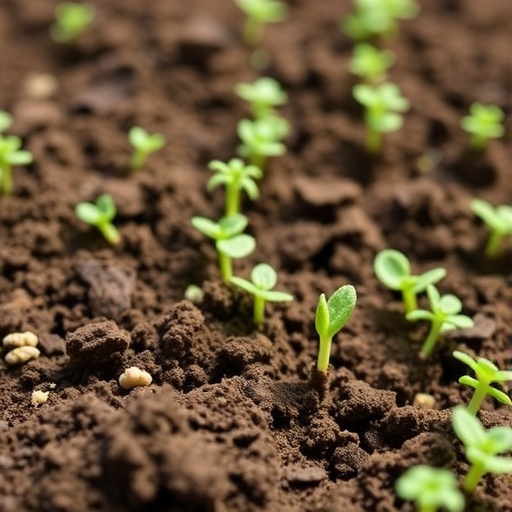Viruses: Unexpected Guardians of Soil Nitrogen and Climate Mitigation
Viruses, widely recognized as agents of disease, are revealing a surprisingly benevolent side in recent groundbreaking research that explores their role in soil ecosystems. Contrary to their notorious reputation, these microscopic entities may be pivotal in reducing the emissions of nitrous oxide (N2O), a greenhouse gas with a global warming potential nearly 300 times that of carbon dioxide. The study, published in the journal Nitrogen Cycling, explores how soil viruses selectively infect and suppress specific microbes that drive the production of this potent gas, shining new light on sustainable agricultural practices and climate change mitigation.
Nitrous oxide emissions predominantly originate from denitrification, a microbial process in soils where excess fertilizers are converted into nitrogen gases. This transformation, essential to the nitrogen cycle, comes with the unintended consequence of releasing N2O into the atmosphere. Historically, efforts to curtail these emissions have centered on managing fertilizer application and manipulating microbial populations. However, limited attention has been given to the soil virome—the vast community of viruses inhabiting the earth beneath our feet—and its ecological impacts.
Researchers affiliated with the Chinese Academy of Sciences embarked on meticulously controlled laboratory experiments to elucidate the influence of viral particles on soil nitrogen dynamics. Utilizing farm soil from the North China Plain, a hotspot for fertilizer usage and associated nitrogen losses, they introduced varying concentrations of active virus extracts. These experimental setups were rigorously monitored using a combination of gas flux measurements and high-throughput genetic sequencing techniques, providing robust evidence that soil viruses could decrease N2O emissions by as much as 20% relative to untreated controls.
Delving deeper into the mechanisms, the study reveals that viruses do not indiscriminately affect soil microbial communities. Instead, they specifically target denitrifying bacteria possessing the genetic machinery to produce nitrous oxide. Prominent among these microbial groups are members of the Pseudomonadota phylum, ubiquitous soil bacteria recognized for their role in nitrogen cycling. Viral predation on these groups results in diminished N2O generation, underscoring a fine-tuned ecological interaction with profound implications for greenhouse gas regulation.
Further network analyses illuminated the complexity of virus-microbe interactions under increased viral loads. Soils enriched with viruses exhibited a dense network of interactions, indicative of the viruses reshaping microbial community structure dynamically. These findings attest to viruses as active ecological engineers rather than passive soil inhabitants, capable of modulating microbial functions that underpin biogeochemical cycles and atmospheric chemistry.
Senior author Shuping Qin emphasized the paradigm shift this research entails: viruses are not solely agents of destruction but may be harnessed as allies within climate-smart agricultural strategies. This newly uncovered role for viruses paves the way for innovative approaches that leverage phage therapy concepts—where viruses are deliberately employed to modulate microbial populations—to specifically suppress microbes responsible for greenhouse gas emissions.
Despite the encouraging laboratory results, the translation of these findings to open-field agricultural systems remains a critical next step. The research team calls for extensive studies addressing the stability, efficacy, and safety of viral applications under variable environmental conditions. Real-world soils present complex challenges, from microbial diversity shifts to potential off-target effects, which must be navigated to unlock viral solutions for sustainable nitrogen management.
Beyond their immediate climate benefits, the involvement of viruses in soil nitrogen cycling invites a reevaluation of soil ecosystems’ intricacy. Viruses represent an often-overlooked dimension of soil biodiversity that can influence nutrient turnover and ecosystem resilience. Recognizing their role enriches our understanding of terrestrial microbial ecology and opens novel research avenues at the interface of virology, microbiology, and environmental science.
The strategic use of soil viruses to mitigate nitrous oxide emissions aligns well with global efforts to reduce agriculture’s environmental footprint. Fertilizer-driven nitrogen losses contribute not only to greenhouse gas accumulation but also to water eutrophication and ecosystem disruption. Targeting denitrifiers through viral means may offer a dual advantage by lowering atmospheric N2O release and enhancing nitrogen retention in soils, thereby improving fertilizer use efficiency.
Methodologically, the study set a precedent by combining classical soil gas measurement techniques with cutting-edge molecular tools. The integration of metagenomics enabled precise identification of viral targets and elucidation of shifts in bacterial community composition post viral infection. Such interdisciplinary approaches are critical for untangling the complex soil microbiome interactions and charting pathways for intervention.
This research underscores the need for a holistic approach to climate mitigation, embracing both the micro and macro facets of ecosystem functioning. The hidden potential of viruses as natural regulators within the nitrogen cycle exemplifies the remarkable interdependencies shaping our planet’s biogeochemical health. Harnessing these relationships could revolutionize agricultural management and contribute significantly to meeting global climate targets.
In summary, the discovery that soil viruses can selectively infect denitrifying bacteria to curb nitrous oxide emissions invites a transformative perspective on microbial ecology and climate change mitigation. It challenges conventional narratives about viruses and spotlights them as crucial, yet underappreciated, players in sustaining environmental balance. As investigations continue, the prospect of virus-informed agriculture offers a promising frontier in our collective quest for a sustainable future.
Subject of Research: Not applicable
Article Title: Viruses mitigate soil nitrogen loss and N2O emissions during denitrification by selectively infecting denitrifiers
News Publication Date: 17-Sep-2025
References:
Song W, Yao J, Fu Y, Qin S. 2025. Viruses mitigate soil nitrogen loss and N2O emissions during denitrification by selectively infecting denitrifiers. Nitrogen Cycling 1: e004. DOI: 10.48130/nc-0025-0002
Image Credits: Wei Song, Jinzhi Yao, Yingdong Fu & Shuping Qin
Keywords: Nitrogen cycle, Nitrogen, Climate change, Greenhouse gases




